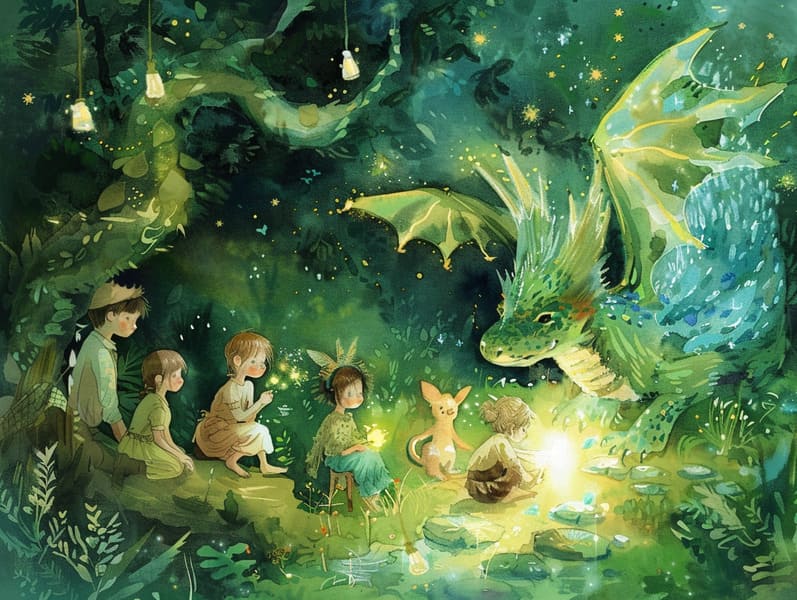
Nightfall is a cherished time for caregivers and children. It’s a ritual to settle down, get cozy, and revel in the joy of nighttime tales.
For decades, children's bedtime stories have been a beloved custom, offering more than just a way to rest. They provide an occasion for relationship building, learning, and sparking dreams.
The Essential Role of Bedtime Stories
Bedtime stories for kids mean more than a way to finish the day. They play a crucial role in a child’s progress and in building the caregiver-child relationship. Here’s why they matter:
1. Quality Time: Reading together at bedtime builds a special period of closeness between kids and their parents. It’s a moment of intimacy that helps children feel cherished and safe.
2. Vocabulary Building: Being read to helps children develop their communication skills. They understand new expressions, understand syntax, and improve their understanding and analytical skills abilities.
3. Creative Thinking: Children's tales lead them to magical worlds, fostering imagination. They imagine characters, settings, and adventures, which stimulates their creativity.
4. Emotional Understanding: Stories for children often present characters facing issues and reactions. These narratives help kids understand and work through their own reactions, enhancing feeling recognition.
5. Intellectual Growth: Following a story helps children develop mental engagement, recollection, and reasoning skills. They enhance to follow plots, remember aspects, and predict outcomes.
Making Bedtime Stories a Nightly Ritual
Forming a sleep-time routine that involves narrating bedtime stories is doable and worthwhile. Here’s how to develop a valued part of your nightly custom:
1. Pick a Snuggly Spot: Select a peaceful place where you and your child can relax without disturbances. A comfortable bed or a quiet reading nook works perfectly.
2. Choose a Specific Time: Choose a set time each night for tales. Predictability helps children know what to expect and makes the routine simpler to continue.
3. Pick Age-Suitable Stories: Find tales that are tailored to your child’s cognitive level. Toddlers might appreciate books with pictures with clear stories, while grown children may enjoy chapter books with more engaging plots.
4. Animate the Tale: Make the tale be engaging by adding different character voices, adding audio effects, and asking your child to take part. Ask stuff about the story to keep them listening.
5. Make a Calm Setting: Dim the lights, use quiet tones, and create a calming environment to help your child wind down.
Finding the Best Bedtime Stories
There are abundant sources find it here where you can find fantastic bedtime stories for children. Here are some options to explore:
1. Books for Kids: Explore your community library or bookstore to find a great selection of bedtime stories for kids. Perusing the selections together can be a delightful activity that also allows children to decide on stories that they enjoy.
2. Online Sources: There are many places online that offer free bedtime stories. Sites like online story sites provide a variety of short stories for kids that you can get for free. These sites are great for finding new and interesting stories without cost.
3. Audio Books and Story Apps: For nights when you’re too tired to read, think about audiobooks or storytelling apps. These can provide a calm narration to read your child a story, ensuring they still get their bedtime story fix. Apps often offer interactive elements that can engage children further.
4. Personalized Stories: Make your own stories reflecting your child’s passions. Personalized stories can be especially engaging and meaningful. You can bring your child in the crafting process, making them a part of the adventure.
Positive Aspects of Short Stories
Concise stories for kids are highly great for bedtime. They provide all the benefits of longer stories but are more short, making them perfect for calming down before sleep. Here’s why short stories are a wonderful choice:
1. Simple to Understand: Compact stories are direct and simple for kids to grasp, even after a long day. They can quickly grasp the plot and enjoy the story without getting lost.
2. Quick Engagement: These stories rapidly engage children, grabbing their attention and interest. This makes them great for keeping bedtime customs smooth yet enjoyable.
3. Diverse Options: Short stories provide for variety in your bedtime tales. You can pick a different story each night, keeping the custom new and exciting for your child.
4. Efficient Use of Time: For busy parents, brief tales are a efficient way to guarantee children still get their nightly dose of storytelling. They fit well into a full schedule while still offering the full good points of a bedtime story.
The Joy of "Read Me a Story"
The simple phrase, “Tell me a tale,” can give a world of magic for children. Agreeing to this request not only addresses a child’s request for attention and engagement but also establishes lasting memories. Here’s why it’s wonderful:
1. Relationship: Reading aloud to your child fosters a deep emotional connection. It’s a time for proximity, sharing, and bonding.
2. Custom: Creating a bedtime story routine creates a important tradition that children anticipate every night. It’s a practice that can be continued through generations.
3. Mutual Learning: As you tell stories, you’ll watch your child’s advancement and growth. Their engagement, reactions, and understanding of the stories grow, offering insights into their developing minds.
4. A Safe Haven: Bedtime stories provide a safe space for children to understand emotions, face fears, and find comfort in the reliable presence of a parent.
To Conclude
Nightly tales for children are a powerful tool for encouraging a child’s advancement and establishing unforgettable experiences of bonding.